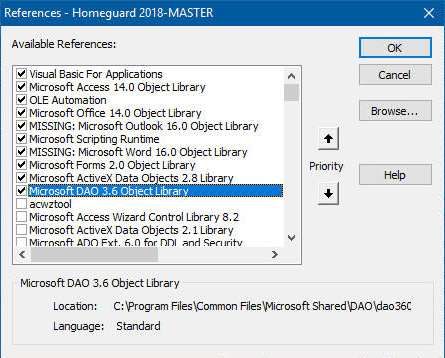Microsoft Outlook 14.0 Object Library Mac
- Microsoft Office 16.0 Object Library
- Microsoft Outlook 14.0 Object Library Missing
- Microsoft Word 11.0 Object Library
- Microsoft Office Object Library Download
Note The character combination '/' in the Location column in this table refers to the Home folder of the user. This folder is located under the Users folder on the root of the hard disk. Note In Outlook for Mac 2011 version 14.2.4 and earlier versions, data was appended to the same log file for every Outlook session. In Outlook for Mac 2011 version 14.2.5 and later versions and in Outlook. 2016-1-29 1.首先,勾选outlook组件《1》右击工程文件的Reference,选择Add ReferencC# 公司新员工入职往往需要配置outlook信息,而并不是每一个都会去看枯燥的配置说明文档,直接就去找IT了,导致IT工作量大大增加,所以就有一个需求说能不能有个什么. Apr 12, 2014 Microsoft Outlook 14 corresponds to Outlook 2010. Instead, you have to look for the Microsoft Outlook 15.0 Object Library entry in the list of available references. You can read more about this in the How to automate Outlook from another program article. You can select another application's objects that you want available in your code by setting a reference to that application's object library. Add an object. From the Developer tab, open a Visual Basic project window. See Make the Developer tab visible below if it's not open. On the Tools menu, click References.
-->If you use the objects in other applications as part of your Visual Basic application, you may want to establish a reference to the object libraries of those applications. Before you can do that, you must first be sure that the application provides an object library.
Microsoft macro assembler visual studio 2019. To see if an application provides an object library
From the Tools menu, choose References to display the References dialog box.
The References dialog box shows all object libraries registered with the operating system. Scroll through the list for the application whose object library you want to reference. If the application isn't listed, you can use the Browse button to search for object libraries (*.olb and *.tlb) or executable files (*.exe and *.dll on Windows). References whose check boxes are selected are used by your project; those that aren't selected are not used, but can be added.
To add an object library reference to your project
Select the object library reference in the Available References box in the References dialog box and choose OK. Your Visual Basic project now has a reference to the application's object library. If you open the Object Browser (press F2) and select the application's library, it displays the objects provided by the selected object library, as well as each object's methods and properties.
In the Object Browser, you can select a class in the Classes box and select a method or property in the Members box. Microsoft word 2003 run macro. Use copy and paste to add the syntax to your code.

See also
Support and feedback
Have questions or feedback about Office VBA or this documentation? Please see Office VBA support and feedback for guidance about the ways you can receive support and provide feedback.
Microsoft Office 16.0 Object Library
-->If you use the objects in other applications as part of your Visual Basic application, you may want to establish a reference to the object libraries of those applications. Before you can do that, you must first be sure that the application provides an object library.
To see if an application provides an object library
From the Tools menu, choose References to display the References dialog box.
The References dialog box shows all object libraries registered with the operating system. Scroll through the list for the application whose object library you want to reference. If the application isn't listed, you can use the Browse button to search for object libraries (*.olb and *.tlb) or executable files (*.exe and *.dll on Windows). References whose check boxes are selected are used by your project; those that aren't selected are not used, but can be added.
To add an object library reference to your project
Select the object library reference in the Available References box in the References dialog box and choose OK. Your Visual Basic project now has a reference to the application's object library. If you open the Object Browser (press F2) and select the application's library, it displays the objects provided by the selected object library, as well as each object's methods and properties.
In the Object Browser, you can select a class in the Classes box and select a method or property in the Members box. Use copy and paste to add the syntax to your code.
Microsoft Outlook 14.0 Object Library Missing
See also
Microsoft Word 11.0 Object Library
Support and feedback
Microsoft Office Object Library Download
Have questions or feedback about Office VBA or this documentation? Please see Office VBA support and feedback for guidance about the ways you can receive support and provide feedback.